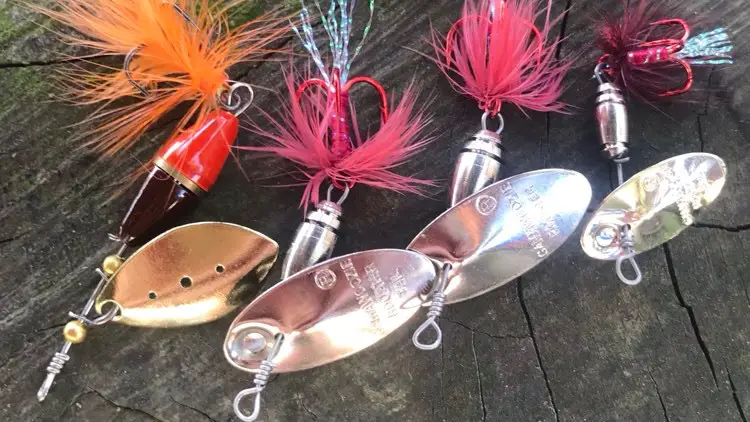All in-line spinners can catch trout, but not all are created equal. Generally speaking, the more you pay the better the quality, the blades spin more reliably, and the wires are less likely to bend.
The premium in-line spinners catch more fish because they keep working cast after cast. A spinner with a stuck, or sporadically rotating blade is not going to catch much.
Inline spinners are one of my favorite styles of trout lures. Over the previous two decades I must have tried and fished with well over 30 different brands and designs. In this article, I aim to answer all questions regarding catching trout on in-line spinners.
I have caught more trout on inline spinners than any other style of lure. They are that good.
I do not have exact records, but close to 90% of my first 100 trout were caught on in-line spinners. They simply work, and unlike spoons, they are a very easy lure to effectively fish with. Even today where I mostly fly fish or use jerkbaits in-line spinners still account for the majority of trout I catch while spinning.
- Check here to read my guide on fishing jerkbaits for trout.
- Check here to read my guide comparing spoons and spinners.
Quick Summary
This article has gotten too long. So I decided to write a quick summary.
Best Inline Spinner for shallow streams?
When fishing in very shallow water, where snags are likely. I like using a spinner that uses a blade which creates a lot of lift. The Colorado blade is usually my first choice, the wide profile sinks slowly and it creates a lot of uplift on the retrieve. This helps prevent the lure from snagging.
A good option is the Joe Flies, they sink slowly and tend to raise during the retrieve, perfect for working the ripples. My backup option is to use a French bladed spinner such as the Mepps Agilia.
To further reduce the chance of snags, and probably reduce trout mortality I suggest changing to a single hook. I also prefer fishing braid, because it allows me to feel the spinner at all times so I can better speed up my retrieve to keep it from snagging.
Best inline Spinner for fast flowing rivers?
When fishing big water or fast rivers I want a heavy spinner that sinks fast. That is because trout are likely to be holding close to the bottom out of the current. So I need my spinner to reach them for any hope of catching one.
I usually reach for a Blue Fox Vibrax or a Panther martin. The Blue Fox Vibrax is better in fast water, where you want to get the blade spinning instantly, it also has a very loud internal vibration which allows the spinner to be heard over the roar of the river.
The Panther Martin is better if you want the spinner to sink quickly to the bottom before starting the retrieve. The Panther Martin also creates a strong vibration, and like the Vibrax it must be easier for trout to sense over the roar of the water.
Best inline spinner for lakes and ponds?
When fishing still water, I want my spinner to cast far but sink slowly. That is a bit of a contradiction. In still water, there is no current to wash a spinner away so there is no advantage to reaching the bottom quickly.
I probably will suggest using a spinner based around a French blade, such as a Mepps Agilia, or maybe a C.P. Swing (I have not reviewed them yet for this article). You do sacrifice a little casting distance compared with the Panter Martin or Vibrax, but it more than makes up for it by the slower sink rate. It also can be retrieved relatively slowly, giving the following trout more chance to decide to strike.
Do not be tempted to try the long cast version, it uses a different blade and spins better at faster speeds. So not ideal when a slow retrieve is required.
Best inline spinner for trolling?
I prefer to use a spinner with a Colorado blade because the design typically spins at a slower speed than any other. So I suggest using a Joe Fly spiner. When trolling, you want to travel as slow as possible to give the trout plenty of chances to strike.
If you can not find any Joe Flies I suggest using a French blade spinner such as the Mepps Agilia.
Best inline spinner for wary trout in clear water?
When the trout are tricky and hard to catch. I usually reach for a Joe Fly. This is because the lure combines the trout attracting vibrations of a spin blade but the realism of fly or streamer.
A less known strength of the Joe Fly is thanks to its colorado blade it can be retrieved at speeds slower than spinners, this means it spends more time in the strike zone, increasing the chance it will trigger a trout to strike.
Now, Joe Flies can be tricky to cast. So usually best fished on smaller waters, but split shot can be used to increase casting distance.
Joe Flies are also becoming my inline spinner of choice for fishing spin creeks where trout mostly feed upon insect life.
Which spinner for different seasons? (Winter, Summer, Fall, and Spring)
The time of year matters for two main reasons when selecting the best inline spinner to use. These reasons are water temperature and flow levels.
Winter: In the winter, the water is usually very cold, and the trout are holding deep. So a spinner that works well at a slow retrieve, but gets down deep works best. One of my favorite choices is the Mepps Agilia.
Spring: In the spring, the rivers are cold, but flows are high. So inline spinners that handle bigger water work best. In the spring, I favor Blue Fox Vibrax and Panther Martins. In lakes, even roostertails can work well.
Summer: Warm, low water conditions are common over summer. i At this time of year, trout are often sluggish, and reluctant to feed. During the summer, I prefer to fish smaller inline spinners that retrieve slowly. In lakes, trout sometimes hold very deep, so a spinner that sinks fast like a Blue Fox or Panther Martin is a great option.
Fall: is represented by low clear water conditions, but hungry trout. To fish such skinny waters, I favor the likes of Mepps Agila or Joe flies. Panther martins can also work well when targeting trout holding at bottom of holes during their spawning migration. For a more detailed discussion on selecting the best fall lures check here.
6 Best Spinning lures for trout fishing
Panther Martin Review
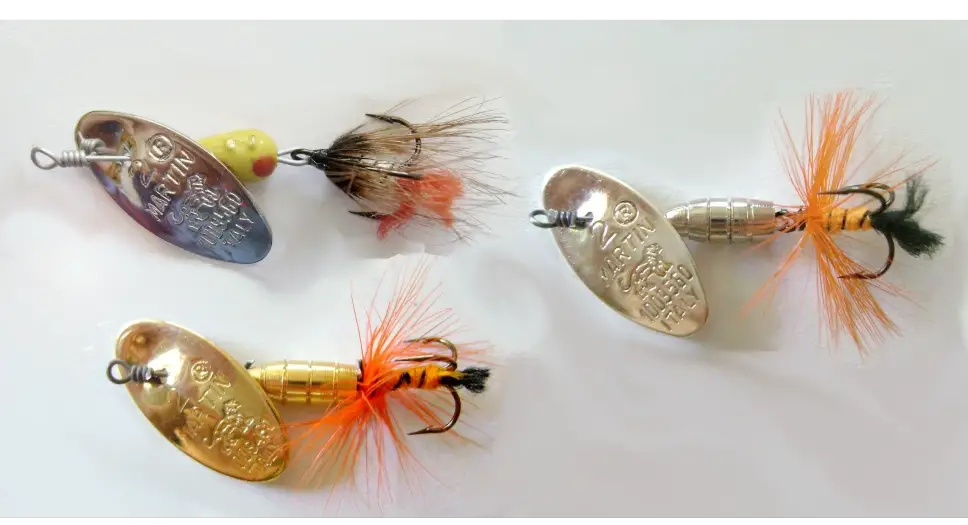
Panther Martins are not shy lures. They are big and loud, and they want the trout to know they are there. If the trout are a being a bit stubborn, dragging a Panther Martin past its mouth often results in a strike out of pure aggression.
Pros and Strengths of Panther Martins
- A large blade that creates a strong vibration and sends plentiful flashes through the water.
- Easy to cast thanks to the relatively heavy construction.
- Sinks fast, well suited for deep water.
- Panther Martin assembles their spinners in the United States, although the original Italian-manufactured ones maintain a cult-like following.
Cons of Panther Martin
- The quick sink rate and loud vibration can make them difficult to fish in shallow streams.
- Recently, Panther Martin moved some production to east Asia. Quite a few anglers reported a drop in durability and overall quality.
Panther Martin has a long history of making lures. They were founded in Italy over 63 years ago, and they claim to be the inventor of the original inline spinner (Mepps also makes the same claim for their Aglia).
Today, Panther Martins are popular lures throughout Europe and in the American Northeast, many trout from Virginia to Maine have fallen victim to them over the years.
The most distinctive feature of the classic Panther Martin Spinner is the larger than average inline blade. Which creates a lot of vibration as it moves through the water, it also gives off plenty of trout attracting flashes. It should go without saying, that the Panther Martin is very easy for trout to see.
The main characteristic of an inline blade is that they do not typically spin on the drop. But, they spin into life the moment forward momentum begins.
By not spinning during the drop, Panther Martins sink faster than other spinners of the same mass. This makes them a great choice for fishing deep pocket water, where you need the spinner to sink quickly before springing into life.
Cheapest way to buy?
Panther Martin sells a variety of combination packs, making them among the cheapest of brand name spinner manufacturers.
One of the cheapest ways to buy Panther Martin spinners suitable for trout fishing is their Deadly dozen box. While not all the lures are ideal for trout, it is still a good way to get a dozen American made lures for just over $3 each.
Panther Martin has a wide selection of of packs, and I spent a long time studying their various packs, trying to find one with what I feel is my favorite combination of colors.
Many were close, but the Pro guide Anywhere 6 Pack comes closest to what I feel works the best across a wide range of fishing conditions. The pack basically covers all the bases, with a silver spinner for sunny conditions, a gold and dark blade for cloudy conditions, and finally a more natural pattern for wary trout. At around $3.60 per spinner, it is a good saving over buying them individually.
Mepps Aglia Review
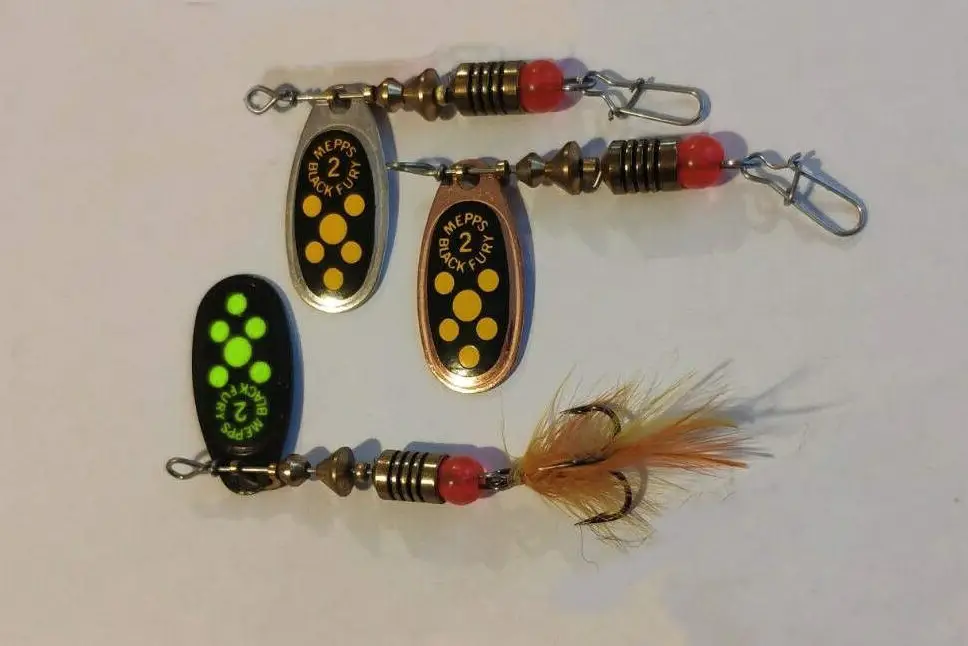
Mepps Aglia spinners feature a French blade. This design of blade typically spins best at a moderate retrieve, and it creates a lot of upwards lift. These two factors combined make the Mepps Aglia a great choice for shallow streams, creeks, and skinny ripples.
Pros and Strengths of Mepps Agilia
- The Mepps Aglia blade rotates quickly at the start of the retrieve.
- Excellent build quality and durability.
- More finesse than Panther Martin’s or a Vibrax making the Aglia a better option when the trout are a bit timid.
- Mepps Spinners are small but dense, so are decent to cast.
- Sinks slower than most inline spinners, well suited for streams and shallows.
Cons of Mepps Agilia
- They can be light and difficult to fish in strong currents.
- The blade, at times, can be reluctant to spin at very slow retrieves.
- Not the best option for lakes or big water
I can still remember my first Mepp in-line spinner. It was a size #1 black fury which I found hanging from a willow branch across a small pool I was fishing. Being a poor student, I did not hesitate to swim across and retrieve it. Compared with the cheap spinners and lures I was using, it was a thing of beauty. I landed many good brown trout on it. Unlike the cheap lures I was using, it never corroded and I could always retrieve it.
Invented in 1938 France, the Aglia sold in the millions. The Mepps Aglia was the original in-line spinner. Today they are made in the United States and France.
They are constructed from very high quality components that are coated in a durable and chip-resistant finish. Based on my own fishing experience, I have found the Mepps Aglia to be the most durable of all the major brands. It is very rare to bend the wire.
The well deserved reputation justifies the price premium. When Mepps Aglia is held beside a cheaper imitation, there is an obvious difference in quality. The Mepps Aglia simply feels more premium.
Mepps agilia can be fished in all kinds and depths of water, but they perform best in shallower runs and streams. They sink slowly, increasing the time in the strike zone.
Mepps Agila cast surprisingly well for their weight, while not class leading for distance they still cast reasonably well. If you want more casting distance, then it is worth trying the Aglia Long Cast. Designed with increased weight and a more aerodynamic which allows for longer casts.
Another highly rated Spinner from the Mepps stable is the Thunder Bug, the unique design better mimics larger insects such as its namesake. The Thunder bug is a petite lure, so ideal for trout fishing in small streams.
The cheapest way to buy?
For better value, I suggest purchasing a combo pack that comes with several of the more popular models. One of the best value-for-money packs is the Mepps Aglia Plain Trout Fishing Lure Pocket Pack. Costing $4.30 per spinner.
Check my comprehensive Agilia review here.
Blue Fox Vibrax Review
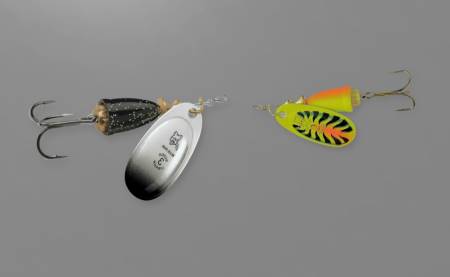
Blue Fox is best known for its Vibrax in-line spinner. Due to its dense construction and loud vibration, the Blue Fox Vibrax is great for deeper pools or faster water where other lighter spinners just dance across the surface. The loud vibration allows the blue fox to be heard over the roar of rapids.
Strengths of Blue Fox Vibrax
- Heavy design, which means it sinks fast and swims deep.
- The extra weight, also makes the Vibrax much easier to cast.
- Design limits line twists
- Equipped with VMC hooks.
- Loud vibrations allow trout to sense it through loud water
Cons of Blue Fox Vibrax
- Not so great in shallow, skinny water.
- The loud vibrations can be a double edge sword. At times, I suspect it is too loud in quiet water when targeting less aggressive trout.
The design of the Vibrax emits a ‘sonic vibration’, this combined with the vibrations of the blade gives the Vibrax a loud presence in the water. Trout know when it is nearby! This sound can trigger aggressive trout into striking, but can also spook more cautious fish. It is a double edge sword in that regard.
It really shines when fishing in big water. The extra weight gets it down deep, and the loud vibrations can get the trout’s attention over the roar of the river. Likewise, it is a great in-line spinner for making longer casts when fishing lakes or larger rivers.
I often fish them on windy days, when I need to cast powerfully into a gusty headwind.
The rotating brass gear assists in reducing twists. Line twists can be a major annoyance when fishing inline spinners.
All Blue Fox spinners come equipped with VMC hooks. They are good quality, and I have never had one let me down. For trout, I rate VMC hooks as good as any on the market. There is no need to worry about cheap hooks bending or straightening out when fighting the trout of a lifetime.
The Vibrax is not that well suited for shallow waters such as streams or slow ripples. It sinks too quickly and spends most of the time snagging rocks. It can be kept off the bottom with a faster retrieve, but that in turn reduces the amount of time the lure remains in the strike zone, and trout, in general, prefer a slower retrieve.
In the United States, Blue Fox Spinners are the most popular on the West Coast. Partly because of the deeper swifter rivers that are more commonly fished there. Blue Fox spinners also have a strong following in Canada, Northern Europe, and New Zealand.
For more information on Vibrax spinners read my dedicated review.
Cheapest way to buy?
Blue Fox is owned by Rapala, so the Vibrax can be brought in most countries where trout fishing occurs. Alternatively, they can be purchased directly from Rapala.com , if you use the promo code fish10 you can receive a 10% discount (affiliate link).
The best way to save some money when buying Blue Fox spinners is to purchase a combination pack such as the Super Vibrax Tri-pack. At the time of writing, they retail for around $9.50, or $3.15 per lure.
Another great value pack is the Blue Fox Flash series kit. This pack comes with five Blue Fox spinners retail for around $12.98. Which is $2.60 per spinner, making them great value for money.
These holographic spinners by design run at a depth of five feet. The extra bling makes them an excellent choice for targeting still water rainbow trout.
Joe Flies Inline Spinner Review
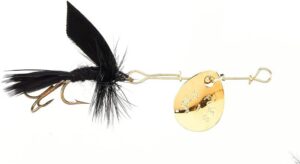
If you can not decide between a spinner or a streamer then Joe Flies might just be the answer. A Joe Fly spinner is simply a small wet fly or streamer which trails behind a rotating metal blade. This combination might just be the best of both styles.
The Key Differences
- Excellent spinner for fishing shallows and over gravel ridges. Anywhere trout are feeding only a few inches below the surface.
- Joe Flies are extremely lightweight and are less aerodynamic than most in-line spinners. There is no hiding the fact, that they are difficult to cast any reasonable distance. For this reason, many fishermen only use them when fishing small streams and ponds where long casts are less important.
Joe Flies, a popular lure since 1961, grabs attention primarily for its trailing fly, but in my view the real standout feature lies in its Colorado blade. The slow-rotating Colorado blade allows for slow retrieval speeds, meaning more time in the strike zone. They also work well in cold water conditions or when trout are feeling sluggish.
In addition to the slow retrieve, Joe Flies are designed to be lightweight, which makes them an ideal choice for fishing in shallow water where other spinners may sink too quickly and snag the bottom.
The standard Joe Flies has no additional weight relying mostly on the blade for weight. Although the Super Striker Series has a brass body allowing them to weigh up to 1/4oz. They are the best choice when fishing bigger water.
The lightweight construction of Joe Flies does make them difficult to cast accurately and over longer distances. Some fishermen opt to use split shot or additional weight to enhance casting and fish Joe Flies in deeper water. A few pieces of split shot can also assist in getting them down deeper towards the bottom of the pool.
One popular method to fish them is to cast down current and then retrieve slowly with the rod tip close to the surface. This slow retrieve gives plenty of time for hungry trout to strike at the trailing fly. The current flowing past the lure helps give its action, a surprisingly effective design when a slow retrieve is required.
Overall, Joe Flies’ combination of the attention-grabbing colorado blade, slow retrieve, finesse presentation, and lightweight design makes it a versatile and effective option for fishing in certain conditions.
One thing I know for certain is that flies typically outfish spinners in clear water conditions.
The cheapest way to buy?
Like for all in-line Spinners, the best value comes from buying multipacks such as the Hot4trout.
If you can not find the packs in your local stores, I suggest heading to the Joe Flies website to check out their selection. At the time of writing, they were overpriced on Amazon.
Worden’s Original Rooster Tail
The Wodens Rooster Tail is best known for its pulsating hackle feathers, but in my opinion, the aspect which really sets them apart is not the Rooster Tail, but the long, slender willow blade.
Pros and Strengths of Rooster tail
- An excellent option for fishing in snag prone areas. The long willow blade, when retrieved with enough pace can deflect the hooks away from snags such as logs.
- Rooster tails also sink quickly, so if you want to fish deep fast they are a good option.
- Less Vibration than the likes of Blue Fox or Panther Martin, so a good option in deep still water where a loud lure might scare trout.
Cons of Rooster Tail
- Works best at a fast retrieve, which can be offputting for trout.
- The blade can be reluctant to spin. Requires fast acceleration to get it going.
- The wire shaft bends easily, certainly more fragile than the likes of Blue Fox and Mepps. While it is possible, to attempt to straighten the wire. It is unlikely to do it perfectly so which further hampers the ability of the blade to spin.
I do not know what to think of the Rooster Tail, in my view, there are simply better trout spinners on the market. But it still has some niche applications.
Rooster tails work best at a faster retrieve because trout are lazy fish. It does not really give them enough time to strike. So they really only work when trout are in the mood to feed.
Rooster Tails use a willow leaf blade, this blade does not spin on the drop. This results in a very fast sinking lure.
Now, the willow blade can help prevent snags. It is much longer than wide. That means when retrieved close to structure or the bottom, the blade nearly always hits before the hook flicking the lure away.
It is a bit quieter on the retrieve than Blue Fox or Panther Martin’s, so certainly could be worth using when deep-holding trout are a bit shy. Just need to include pauses in the retrieve to give the trout a chance to close in and strike.
All major spinner companies have dressed lures, for example, Mepps and Panther Martin use bucktails while Blue Fox dresses some of their hooks with calf tail.
All companies seem to have variations that use Flash-A-Bou or similar synthetic fibers. When a tail fluff is not used, hooks are often decorated with hot spots made from tube or plastic. So, the hackle tail feathers is not really a point of difference for Rooster Tail.
I might have sounded a bit harsh, and I know the Rooster Tail is a favorite among many trout anglers. It certainly does catch trout, I just feel other inline spinners do it better.
Are Cheap Chinese spinners any Good?
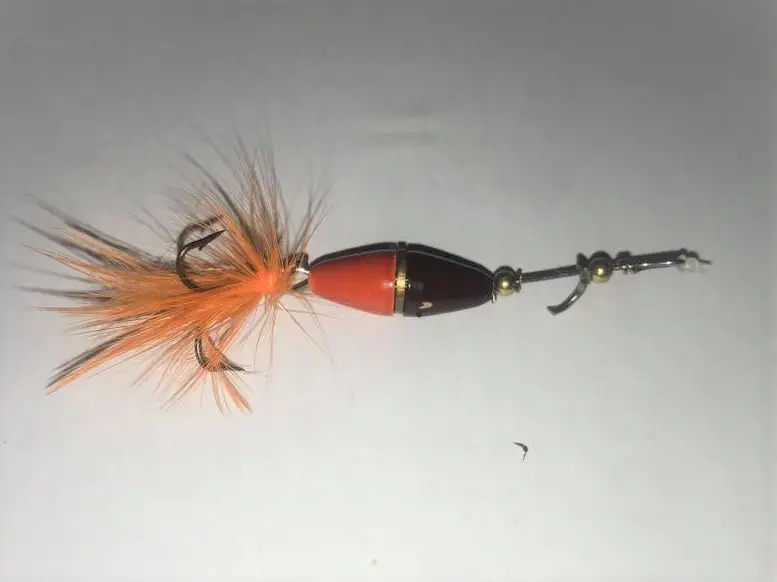
Chinese made spinners have saturated the market over the last couple of decades. At first glance, these spinners look the part, with a wide selection of colors and blade variations. Unfortunately, these spinners are typically of poor quality. They cut too many corners, including the use of poor quality metal. The wire which holds the spinner together is often thin and soft. The blades are rust prone and only spin when they feel like it. With hooks so soft and brittle, that I expect them to bend or snap even on a modest fish.
But the low price is attractive, it is possible to buy large numbers of generic spinners for the price of a single name brand product. I personally struggle to trust them to hold a big trout, but at the same time, I do not advise against trying them. They can catch fish, I even use them myself when fishing in overgrown streams or around foul ground where I expect to lose gear. Feels much better losing a 50c spinner compared with a $7 one. One piece of advice is to replace the supplied hook with a better quality one. For value, I recommend the Mustad 3351 classic treble hook.
How To Catch Trout on inline Spinner?
Spinners or spin blades are lures that have a blade that spins during the retrieve. The spinning motion sends an array of vibrations and colorful flashes through the water to catch the attention of any nearby trout. The flash and vibration together can really provoke a trout into striking.
Traditional spinners, like most metal lures, do not attempt to replicate the appearance of a trout’s prey. Rather, the vibrations help replicate the shock waves and movements of a small fish swimming.
Many books have been written on the feeding habits of trout. I am going to cover the key points. Trout often hold on to the current’s edge and grab any food as it drifts past.
Sometimes trout hold tight against the shoreline, or further out near a rock in the current. Trout more often hold just in front of a rock or several feet behind. Gravel bars, and submerge logs work similarly.
With experience, you will learn the preferred holding places in your local river.
Which brand of in-line spinners is most popular?
Don’t just take my word for it. I surveyed one of the largest online fishing communities for their favorite trout lure. Out of 51 responses, 64% preferred in-line spinners. Second place went to Spoons (25% support) and third to Jerkbaits (7.5%). Most respondents fish with all styles of lures.
I surveyed a large online fishing community for their favorite trout lures. The chart below is the preferred brands for users of in-line spinners. To my surprise, Panther Martin was a clear winner, with Rooster Tails sneaking into second.
There was a third place draw between Mepps, Joe Flies, and Blue Fox. I was expecting a much stronger showing from Mepps. Out of all lures, and not just in-line spinners Kastmaster spoon was second equal with 10 backers.
Later in this review, I have a comprehensive write up on Panther Martins, Mepps, and Blue Fox in-line spinners which are models I rate highly. I am personally not a fan of dressed hooks like on the Rooster Tails so I have not tried their spinners. I do intend to start fishing Roosters Tails so I can include them in this guide.
| Spinner model | Votes |
|---|---|
| Panther Martin | 16 |
| Rooster Tails | 10 |
| Mepps | 8 |
| Joes Flies | 8 |
| Blue Fox | 8 |
| Thomas Spinner | 1 |
Selecting the right in-line spinner for trout fishing
Selecting the best performing trout in-line spinner for your local fishing spot can be a challenge. There are hundreds of models, variations, and colorful combinations. Despite similar appearances, they are not created equal. They can vary regarding the quality of design and the materials used.
No one trout fishing hole is identical. Every stream, river, backwater or lake has its own characteristics. Trout all have their own feeding habits and preferences. To match a spinner to the fish is paramount for long-term success. In this article, I will cover several proven and time-tested spinners. They will help maximize your chances in all varying types of water
Best Colors and Patterns for inline spinners
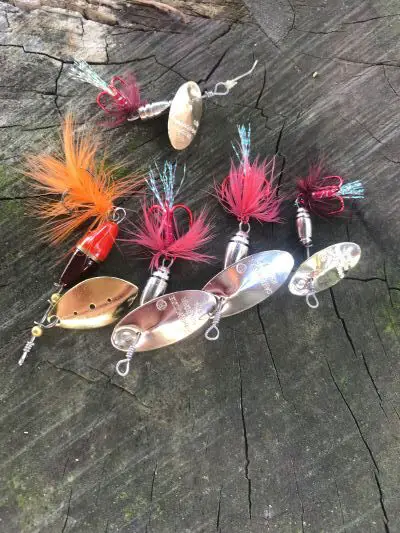
Many factors determine which color a trout is most likely to strike. Water clarity, weather, temperature, and swiftness of water can all influence the trout’s feeding preference.
Brown, Rainbow, and Brook char also have varying feeding habits and different responses to lures. One day trout might smash anything which moves, the next they might turn a blind eye to every lure which swims by. If you see a trout is feeding, you can catch it by putting the right ‘food’ in front of them.
To maximize success when spin fishing, it is important to carry a diverse spinner selection with you. Make sure they are in opposing and contrasting colors and natural-looking patterns.
Never be afraid to experiment with different lures. What works today might not work tomorrow or vice versa. It is impossible to know what motivates trout to strike, likely a combination of hunger or anger. There are ways to better your odds.
The spinner’s color helps, but many other factors influence whether a trout strikes. One trick is to bring a black felt pen, to change or to touch up the lures pattern while fishing.
Key points
- Water Clarity is important, trout are more shy when the water is clear. So using a dull or natural pattern often increases the chance of success when the fish are wary. When fishing dirty, discolored, or turbulent water, bright colors stand out against the murk and might be just the ticket.
- In fly-fishing there is a saying to “match the hatch”. Basically make your fly match what the trout feeding upon, or at least the prey which is in the river. It is no different for spin fishing. If you can see small fish or large insects, try to match your spinner colors to best represent them.
- The Weather plays an important role. When the sun is bright, use a golden spinner. While on a dull overcast day, a silver spinner better matches the clouds.
- Some days multi-color spinners can be the answer. Orange/Gold, Black/Red, Silver/Blue, Bronze/black have all brought me and others a lot of success.
What size in-line spinner to fish?
Several factors go into selecting the optimal weight of spinner to fish. The best general-purpose weight to fish is 1/16oz. I feel it is a suitable compromise that successfully catches fish under most conditions.
In general, the smaller and warier the trout are the smaller the lure should be. A cunning old trophy trout is often more likely to snatch a tiny 1/32oz spinner compared with a much larger lure. Trout do not get large by taking risks, and smaller lures better represent the aquatic life they predominately feed upon. Matching the hatch is matching the size of food currently available. More often than not, it is small.
There are situations when large 1/8oz in-line spinners are worth fishing. These large spinners are heavier, which makes them easier to cast long distances. Making it possible to cover a lot more water. They are a good choice for big rivers and deep lakes where you need to cover a lot of water to find the fish. 1/8oz spinners sink faster, making them a good option for fishing fast water.
Best line weight to use with in-line spinners
Using too heavy of line can dull down the action and vibration of in-line spinners. The best and most consistent action to catch more trout is when the lure flutters through the water.
To achieve this, I recommend fishing monofilament no heavier than 6lb, and if predominately fishing tiny 1/32oz lures drop further to 4lb.
Thinner diameter line, due to less resistance also allows spinners to sink faster, this can be advantageous when the goal is to get down deep fast.
Superlines, such as Berkley fireline are a great alternative. This woven line never suffers from twists, which is a common problem when fishing in-line spinners on monofilament.
My favorite sizes of spinners for trout are 1/32-ounce for the most finicky fish, 1/16-ounce for most situations, and 1/8-ounce for fishing in fast currents.
Best color spinners for trout?
Brown Trout
Fishermen often consider Brown trout to have a cunning and wary reputation. The larger they get the more wary and territorial they become.
Brown trout respond well to more natural and neutral colors. When fishing in fast and discolored waters bright and colorful spinners are worth using. I prefer orange/black and blue/silver combinations.
During the day bright shiny spinners catch a lot of sea run brown trout. Especially when they have been feeding on shoaling baitfish. For night fishing dark and bold lures are popular, alternatively luminous spinners such as the Blue Fox Classic Vibrax Glow.
Rainbow Trout
Widely known to be feisty, aggressive, and less curious than brown trout. Rainbow trout despite being hard fighters, are normally easier to catch.
Brighter lures work better unless the water is super clear then natural palettes can be more productive. Rainbow trout are not afraid of a little flash. Some of the best trout spinners to use to catch rainbow trout include rooster tails and other decorations.
Brook Trout
Brook Trout are the smallest of the three species and respond best to more natural colors and smaller sizes.
Brooks also have a fondness to go after the color white. So always carry a few small white spinners when targeting brook trout.
What is the best type of blade for inline spinners?
Apparently, there are at least 17 different blade designs used on spinners, and, below I will briefly discuss the main four types of blades. For a more detailed discussion check here.
Inline Blade: Inline Spinners, commonly found on Panther Martins sink quickly due to the blade not spinning on the drop. They run relatively deep. They are a good spinner for fishing deep water and in current.
French Blade: These blades rotate at a moderate speed and are also very popular on trout spinners. Many Mepp spinners use a French blade. They run at a medium depth, and the blade generates more left than the inline blade. They are a popular choice for slow moving water.
Colorado blade: These blades start to rotate at a very slow speed. Close to 0.6mph. This makes them an ideal blade to use for trolling. The round shape creates a lot of water resistance which slows the lures fall through the water. They are a good option for very shallow water. I assemble my own, but commercially you can find examples of Colorado blades on Joe flies or Mepps Marabou
Willow Leaf Blade. They rotate quickly, but at higher speeds. They are not commonly used for trout fishing. Popular for fast retrieves where instant inertia is required. They also create minimal left making them good for fishing in deep water. Examples of this blade can be found on the Mepps Aglia Long or the Thomas E.P Spin.
How To Fish Spinners in Lakes and Ponds.
I am personally not a big fan of spinners in lakes or still water. Wary trout have sufficient time to check out the spinner before deciding whether to strike or not.
That just means you need to fish, think and plan better compared with fishing faster flowing rivers.
To maximize the chance of success, try to identify structures and features on the lake floor. The main areas where trout feed are along drop-offs, over weed beds, and around stream inlets and river deltas.
When spin fishing deep still water cast out and let the spinner sink to the bottom before retrieving. During the retrieve vary the speed and action, which can be done by jerking and twitching the rod. If fishing deep is not productive, then try varying the depth of your retrieve.
During hot summer weather, trout often seek cooler and more oxygenated water. This is often near river mouths and spring eruption zones. Other times they head into the deeper part of the lake, trying to find refuge from the warmer water near the surface.
If you are not having much success, I suggest changing to a minnow or Jerkbait style lure instead.
How to Fish Spinners in Streams and Rivers
Swift streams and rivers are one of my favorite places to fish spinning lures. It is quite a fast and action pack style of trout fishing. It is generally best to cast upstream past where you expect the trout to be feeding, then pause for a second to give the spinner a chance to sink then quickly retrieve it, making sure there is no slack.
If the spinner skips along the surface, you are winding too fast. Slow down your retrieve or consider switching to a heavier lure. Sometimes, when a trout it is in hot pursuit, it is worth pausing for a moment. That gives the trout the opportunity to strike.
Spinners vs spoons vs Jerkbaits
In-line Spinners or Spoons for trout?
Spinners and spoons both work by generating flashes and vibrations during the retrieve. In-line spinners simply do it better. The rotating blade sends flashes in all directions. Well-designed spinners rotate even at low retrieve speeds.
Spoons can be tricky lures to fish. They certainly make less flash and vibration on a straight retrieve, but they can really excel in certain circumstances, for example, spoons can be bounced along the bottom to target deep-holding fish.
For more information, check my guide on how and when to fish spoons.
In-line spinners or Jerkbaits for trout?
Many fishermen ask are In-line spinners or Rapalas better for trout fishing?
Both have some fundamental differences. Spinners are all very effective thanks to the flashes and vibrations. While Jerkbaits attempt to replicate the appearance and motion of an escaping baitfish.
Spinners can cause trout to strike without thinking, the flash and vibration can trigger trout to attack without them even knowing what they are after. They are less effective on wary wild trout, especially when they have time to check out and inspect the prey. That is where Jerkbaits really shine. Their fishlike appearance can provoke the feeding urge in otherwise suspicious trout.
One disadvantage of fishing inline spinners is that trout are more likely to swallow them. For this reason, when practicing catch and release fishing, it is highly recommended to change out any treble hooks to singles.
In-Line spinners are also denser and more compact. That makes them easier to cast, and quicker to sink. Great for fishing fast ripples, or deep holes where even a sinking Jerkbait might be too slow to reach the bottom.
Compared with Jerkbaits they sink like a rock, ideal for fast flowing guts and swift currents. A similar size sinking Rapala would float downstream while a little Mepps agilia is bouncing off the bottom. When fished against the current, even the smallest of blades start to spin. No need for a fast rapid retrieve meaning the in-line spends more time in the strike zone.

